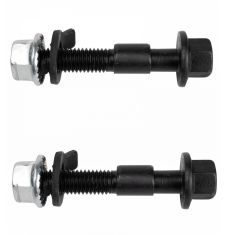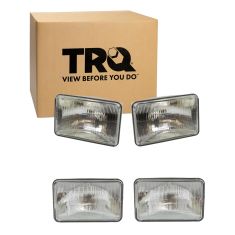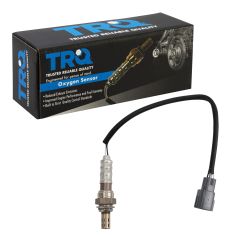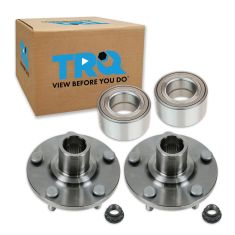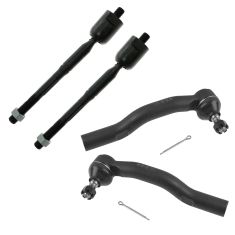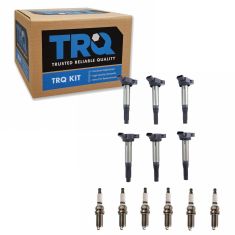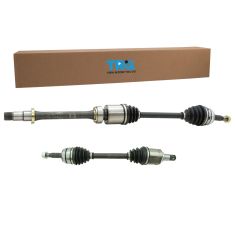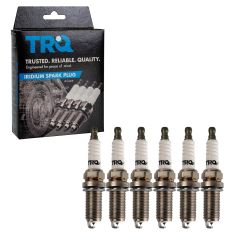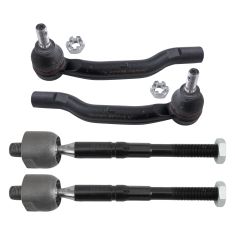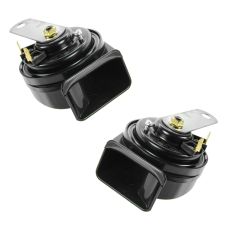Toyota Camry
-
Notify When Available$24.95Save 24%List $32.95 Save $8.00Brand: TRQ - PSA60166$24.95Save 24%List $32.95 Save $8.00
-
Notify When Available$84.95Save 11%List $95.95 Save $11.00
Replaces 4 Piece Headlight Set TRQ LKA93536
Brand: TRQ - LKA93536$84.95Save 11%List $95.95 Save $11.00 -
Notify When Available$42.95Save 19%List $52.95 Save $10.00Brand: TRQ - OSA61308$42.95Save 19%List $52.95 Save $10.00
-
Notify When Available$119.95Save 19%List $148.95 Save $29.00Brand: TRQ - BHA53262$119.95Save 19%List $148.95 Save $29.00
-
Notify When Available
Replaces Toyota Camry Solara Lexus ES330 Front Driver & Passenger Side 4 Piece Tie Rod Set TRQ PSA55412
Brand: TRQ- PSA55412$64.95Save 16%List $76.95 Save $12.00Replaces Toyota Camry Solara Lexus ES330 Front Driver & Passenger Side 4 Piece Tie Rod Set TRQ PSA55412
Brand: TRQ - PSA55412$64.95Save 16%List $76.95 Save $12.00 -
Notify When Available$179.95Save 26%List $241.95 Save $62.00Brand: TRQ - ICA71771$179.95Save 26%List $241.95 Save $62.00
-
Notify When Available
Replaces Toyota Camry Front Driver & Passenger Side 2 Piece CV Axle Assembly Set TRQ CSA72926
Brand: TRQ- CSA72926$219.95Save 13%List $252.95 Save $33.00Brand: TRQ - CSA72926$219.95Save 13%List $252.95 Save $33.00 -
Notify When Available$54.95Save 14%List $63.95 Save $9.00
Replaces 6 Piece Spark Plug Set TRQ SPA02135
Brand: TRQ - SPA02135$54.95Save 14%List $63.95 Save $9.00 -
Notify When Available
Replaces Toyota Avalon Camry Front Driver & Passenger Side 4 Piece Tie Rod Set TRQ PSA73460
Brand: TRQ- PSA73460$84.95Save 17%List $101.95 Save $17.00Brand: TRQ - PSA73460$84.95Save 17%List $101.95 Save $17.00 -
Notify When Available$64.95Save 18%List $78.95 Save $14.00Brand: TRQ - ELA17620$64.95Save 18%List $78.95 Save $14.00
Need Toyota Camry Parts?
One of the most commonly vehicles on the road today, the Toyota Camry has consistently been of the best-selling cars in America over the years. Its stylish exterior, reliability, and affordability make it a favorite sub-luxury mid-size sedan for both casual drivers and enthusiasts alike. However, even an extremely reliable vehicle like the Toyota Camry will experience wear and tear and needs to be maintained in order to keep it purring like it should. Luckily, 1A Auto provides premium Toyota Camry aftermarket replacement parts to replace your worn and broken OEM parts. We supply parts for both the interior and exterior of your Camry, everything from carpeting to mirrors to headlights, taillights, and more! An exceptional vehicle like the Camry deserves to look and run great at all times!
Our product development team spends over 8,000 hours a year researching the best auto parts, and they are carefully selected by our trained engineers so you can rest assured that you are getting the correct, high quality part you need for your Toyota Camry, at a discount price. If we wouldn't put the part in our own vehicles, we won't sell them to anyone else. A new aftermarket replacement Toyota Camry part from 1A Auto will save you 30-50% on average over a comparable new OEM replacement Toyota Camry part that you would get at a dealership, and our new aftermarket Toyota Camry parts are also extremely durable and reliable. Don't overpay for Toyota Camry parts and save yourself from a lot of potential headaches by shopping at 1A Auto.
You can shop for all of your Toyota Camry auto parts online and buy safely and securely right here on our website, or you can call our customer service toll free at 888-844-3393 if you have any questions about any of our parts, or to buy over the phone. With over 150 years combined experience, 1A Auto's customer service representatives are the most qualified to answer your questions about all of our Toyota Camry parts. Our representative’s answer 99.9% of phone calls in less than one minute and emails are responded to within the hour because we know you need answers quickly to get your beloved and dependable Toyota Camry back in working order again. We also know you want your part fast for the same reason; 98% of in stock Toyota Camry parts ship from our warehouse within one business day so that you can get back on the road in no time, and all ground shipping in the continental U.S. is completely free. And, in the unlikely case that you are unhappy with your Toyota Camry auto part for any reason, 1A Auto also offers the only No Hassle return policy for unused items in the industry. Simply put, our competitors can't beat the 1A Advantage. Don't just take it from us - take it from over 50,000 satisfied customers! Like the Toyota Camry, we strive to satisfy our customers and have been doing so for years.
Don't settle for less and let faulty equipment ruin your drive – order from 1A Auto today and get your replacement aftermarket Toyota Camry parts delivered fast. If you happen to be an enthusiastic Toyota Camry owner, have a deep passion, or just want to learn more about it, continue reading below for a look at the vehicle's history and some fun facts.
The Celica Camry
The Camry name was first used for the highest trim level of the Toyota Celica, starting in 1979. The name is an Anglicization of kammuri, the Japanese word for crown. Toyota has a history of naming vehicles after crowns, including the Crown, Corona, Corolla, and the Tiara.
Unlike later Camrys, the Celica Camry shared the Celica’s front-engine, rear-wheel drive layout. It was initially available with a 1.6L or a 1.8L inline-four engine and beam axle suspension. Later in the run, it was upgraded to make a 2.0L engine available and to have independent suspension.
The Camry Branches Out
In light of the oil crises of the 1970s, Toyota was working to develop a front-wheel drive compact car. Front-wheel drive cars tend to be smaller and lighter, making them more fuel efficient. The lack of a driveshaft decreases weight, and the ability to mount the transmission transversely can help designers countdown the length of the car (or improve cabin space).
Many competitors were moving to FWD in the ‘80s. Specifically, the design documents for the Camry cited the Honda Accord and General Motors’ X-body cars as competitors. Toyota engineers worked with a wind tunnel to reduce drag and further increase efficiency, and located the gas tank below the rear seat to save trunk space. The resulting car, released in 1982, was surprisingly spacious for an economy model. It was available with gas or diesel inline-fours ranging from 1.8L to 2L.
Toyota introduced the second generation of the Camry in 1986. Engineers worked on further refining the vehicle’s aerodynamics by subtly curving the boxy hood, adding wind splitters and closing body gaps. This kind of attention to detail led some reviewers to compare the Camry favorably to cars from Mercedes.
The Camry Becomes American
With American interest in Japanese cars growing, and Nissan and Honda building factories in the US, Toyota opened a factory in Georgetown, Kentucky—its first in the US. Toyota then began to build Camrys in the Kentucky plant.
That wasn’t enough for Bob McCurry, an executive from Toyota Motor Sales USA. He wanted a version of the Camry that was more suited to American tastes. He told Toyota executives in Japan that the Camry should be bigger and come with a V6. Toyota resisted at first, but eventually gave in to McCurry’s persistence. In 1991, Toyota released a wider version of the Camry sold in the US and Australia. A new version of the original, narrow-body Camry continued to sell in Japan. The wide-bodied version was sold in Japan as the Scepter (continuing the royal accoutrements naming scheme). Both versions shared the same chassis, doors, and fenders. The wide-body version was available with a 3.0L V6, where the biggest engine for the narrow-body version was a 2.5L inline-four.
The second generation of the wide-body Camry brought mostly minor changes, including slightly improved engines and sleeker body styling, but proved to be a breakthrough moment in the Camry’s history. This generation was released in 1996. In 1997, the Camry became the bestselling car in the US. With its trademark combination of a comfortable interior and good fuel efficiency, the Camry has taken this title every year since, except for 2001 when it lost to a newly updated Honda Accord.
2001 Also saw the first complete redesign of the wide-body Camry. The new vehicle was a couple inches taller and longer than its predecessor, but ended up producing less drag. A number of safety features were also added, including side airbags and stability control. Engine size increased again, now ranging from 2.4L to 3.3L.
Recent Developments
The Camry was redesigned again for 2006. Optional features from previous models—such as stability control and traction control—became standard with this generation. The wide-body Camry also became the standard Camry for Japan with this generation.
2006 saw the introduction of the Toyota Camry Hybrid. The Camry Hybrid used Toyota’s Hybrid Synergy Drive a refinement of the Toyota Hybrid System used in the first generation Prius. This system allows the car to run on the electric motor only, unlike many other hybrids. Like most hybrids, the Camry can also use the gasoline and electric motors together, or the gas motor alone. The Camry Hybrid had other features including a flattened underbody for reduced drag. With these technologies, the Camry Hybrid was able to achieve an EPA rating of 34 miles per gallon.
The most recent generation of the Camry was released in 2011. The new version has updated interior and exterior styling but carries over the same engines, including the hybrid system. The new Camry Hybrid can achieve 40 mpg due to reduced weight, improved aerodynamics, and specialty low-resistance tires.
In 2015, the Camry was named the most “American Made Car.” That may seem strange for a car from a Japanese company, but the Camrys bought by US consumers are made in Kentucky with 75% of its parts sourced from the United States. The Camry took over the title from the Ford F-150. In the end, it’s no surprise that this little Japanese car has been so successful in the US when you consider the lengths Toyota has gone to to tailor it to American tastes.
